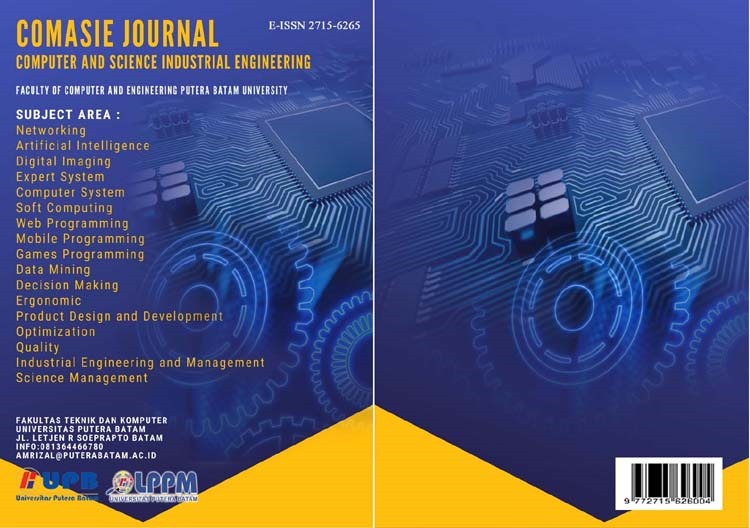PERANCANGAN ULANG TATA LETAK GUDANG DISTRIBUTOR BAN PADA PT XTC
DOI:
https://doi.org/10.33884/comasiejournal.v11i3.9057Keywords:
class-based storage, material handling, warehouse layoutAbstract
The rapid development of global industries and technology has complicated the layout of warehouse facilities in manufacturing. PT XTC, a major tire distributor in Indonesia, faces inefficiencies in its warehouse layout, causing cross movements, poor space utilization, and difficulties for forklift operators. This study aims to redesign the tire layout in PT XTC’s distribution warehouse using the class-based storage method, which groups materials based on popularity to enhance efficiency and productivity. The study employs direct observation, interviews, and literature reviews, collecting data on tire quantities, material inflows, and outflows from October 2023 to March 2024. Data analysis includes calculating the frequency of material movements, classifying materials into fast-moving, medium-moving, and slow-moving categories, and measuring penangan material distances and costs in both the initial and proposed layouts. Results show that the class-based storage method groups materials into class A (67.4%), class B (18.3%), and class C (8.3%). The initial layout shows a material movement distance of 3,514,000 meters and handling costs of Rp.509,530,000, while the redesigned layout reduces these figures to 1,045,800 meters and Rp.151,641,000, respectively. The redesign provides a more efficient space and lower handling costs.
References
Dianto, C., Widiandoko, F., Rahmanasari, D., Yuniaristanto, & Sutopo, W. (2020). Redesign Production Layout Using Dedicated Storage Method: Case Study of PT.Solo Grafika Utama. IOP Conference Series: Materials Science and Engineering, 943(1). https://doi.org/10.1088/1757-899X/943/1/012042
Gozali, L., Marie, I. A., Kustandi, G. M., & Adisurya, E. (2020). Suggestion of Raw Material Gudang Layout Improvement Using Class-Based Storage Method (case study of PT. XYZ). IOP Conference Series: Materials Science and Engineering, 1007(1), 012024.
Meliala, G. N., & Saputra, D. W. (2020). USULAN TATA LETAK GUDANG NON SEMEN MENGGUNAKAN METODE CLASS – BASED STORAGE DI PT INTIAGA SUKSES ABADI CABANG MEDAN. Jurnal Industri Kreatif (JIK), 4(01). https://doi.org/10.36352/jik.v4i01.23
Muhammad, K., Wicaksana, B. P., & Sibarani, A. A. (2023). Gudang layout design with class-based storage approach to minimize material transfer distance. AIP Conference Proceedings, 2482. https://doi.org/10.1063/5.0113824
Rahmandhani, D., & Ekoanindiyo, F. A. (2023). PERBAIKAN TATA LETAK FASILITAS GUDANG DI CV. LK SEMARANG MENGGUNAKAN METODE CLASS BASED STORAGE. Journal of Industrial Engineering and Operation Management, 6(1). https://doi.org/10.31602/jieom.v6i1.10125
Semnasti, T., Semnasti, Y. C. W., Semnasti, N. I. Q., Semnasti, A. S., & Semnasti, T. (2023). Penerapan Relayout Dengan Menggunakan Metode Class Based Storage di PT SMM. WALUYO JATMIKO PROCEEDING. https://doi.org/10.33005/wj.v16i1.78
Tarigan, E., & Zetli, S. (2022). EVALUASI TATA LETAK FASILITAS DI PT MBG PUTRA MANDIRI YOGYAKARTA. JURNAL REKAYASA SISTEM INDUSTRI, 7(2). https://doi.org/10.33884/jrsi.v7i2.5524
Wijaya, H. S., & Palit, H. C. (2021). Perancangan Layout Gudang Bahan Pembantu PT. Sun Paper Source dengan Penerapan Metode Class Based Storage. Jurnal Titra, 9(2).
Yevita Nursyanti, Marlina, N., & Widyasari, R. (2024). Usulan Tata Letak Penyimpanan Barang Jadi pada Industri Manufaktur Menggunakan Metode Class Based Storage. Jurnal Teknologi Dan Manajemen Industri Terapan, 3(I). https://doi.org/10.55826/tmit.v3ii.272














